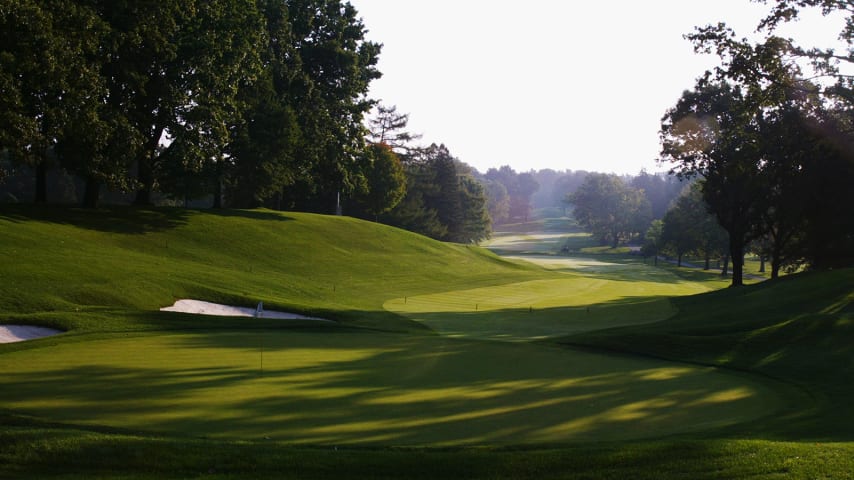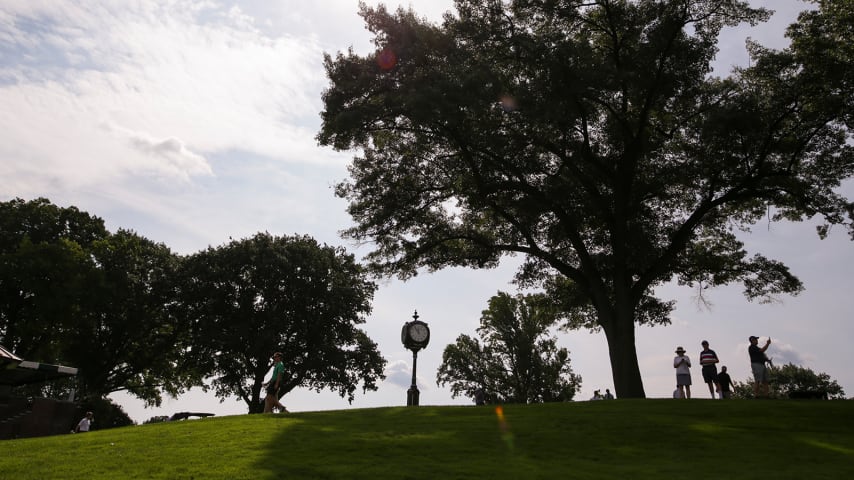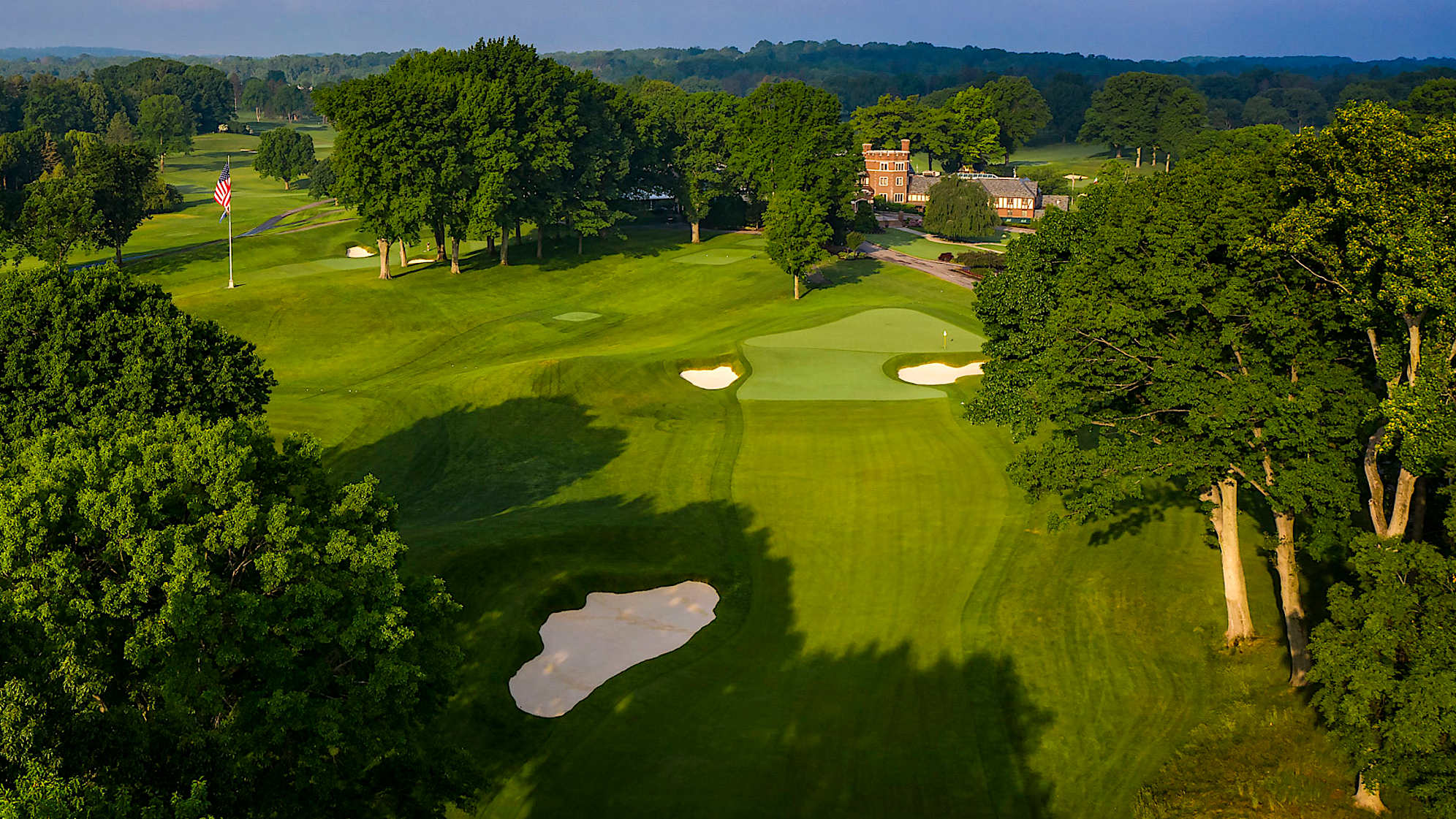Nine things to know: Oak Hill Country Club
9 Min Read

ROCHESTER, NY - JUNE 07: A view of the sixth hole at Oak Hill Country Club on June 7, 2021 in Rochester, New York. (Photo by Gary Kellner/PGA of America).
Written by Bradley S. Klein
Oak Hill Country Club, host of this week’s 105th PGA Championship, typifies distinctly American golf architecture. Located in the leafy Rochester suburb of Pittsford, New York, the course has a major feel and features holes lined with massive trees. The rough is thick and gnarly. The magic carpets down the middle are inviting and yet precariously dotted with hazards. And the feel of the place makes one thankful to be back at one of the game’s mature playing grounds.
Oak Hill has 36 holes, with the East Course claiming the mantle of the tough, broad-shouldered guardian of par. The West Course, a gem in its own right, is marginally more fun and welcoming.
Here are nine things to know about Oak Hill:
1. A MECCA FOR ROSS DESIGNS
The courses at Oak Hill date to a 1924 routing by masterful Golden Age architect Donald Ross after the club moved to its current site. It was originally located next to the Genesee River in downtown Rochester before moving so that the University of Rochester could expand. Ross took a wide-open, 360-acre parcel of land and created a pair of contiguous courses inside what would become the region’s most highly prized residential area.
In fact, this section of metropolitan Rochester would become a mecca of Ross-designed private clubs. Irondequoit Country Club abuts Oak Hill to the south; Country Club of Rochester lies two par 5s to the north; Monroe Golf Club is a mile to the southeast; and over on the west side of town is Brook Lea Country Club – all Ross’ handiwork. A purist in search of the master’s finest work might even venture a little farther afield into upstate New York to capture the full scope of Ross’ genius. Teugega Country Club in Rome and Thendara Golf Club, where the front nine is a timeless Ross design, are highly recommended.
2. CHAMPIONSHIP PEDIGREE
Oak Hill-East has been home to the U.S. Open (1956, 1968, 1989), the PGA Championship (1980, 2003, 2013), the U.S. Senior Open (1984), a Ryder Cup (1995), and the Senior PGA Championship (2008, 2019). Also: two U.S. Amateur Championships, with another on the books for 2027. And it’s no wonder golf’s major governing bodies keep coming back. The grounds are spacious and fan friendly, and access is easy thanks to a local highway network.
Cary Middlecoff, Lee Trevino and Curtis Strange won the U.S. Opens there, while Jack Nicklaus, Shaun Micheel and Jason Dufner were victorious in Oak Hill’s PGA Championships.
The wins by Middlecoff and Strange represented their second U.S. Open titles. For Strange, it also was his second consecutive victory in the U.S. Open (of note, Matt Fitzpatrick is trying to follow in his footsteps by winning a major at Oak Hill the year after claiming one at The Country Club of Brookline). Trevino’s win in the 1968 U.S. Open not only was the first of his six majors, but also his first PGA TOUR win.
Micheel and Dufner both claimed their lone majors at Oak Hill (and for Micheel, it was his lone win on TOUR), while the 1980 PGA was Nicklaus’ fifth and final victory in that event. He is tied with Rochester native Walter Hagen for the most wins in the PGA’s history.

Jason Dufner admires the Wanamaker Trophy after his two-stroke victory at the 95th PGA Championship at Oak Hill Country Club in 2013. (Stuart Franklin/Getty Images)
Most importantly, the course is a demanding test of driving and iron play, its par-4s as tough as those at any major venue. For this week the course will play to a newly lengthened distance of 7,394 yards (par 70) and present the equivalent of a 77.2 rating/151 slope. From where the pros will play, your average 14-index golfer would be playing to a 26 handicap.
3. ICE AGE REMNANTS
You can thank the Ice Age and its leftover moraine – a mass of rocks and sediment carried down and deposited by a glacier – for Oak Hill’s character. Golf architecture is all about utilizing geology: landforms, soil conditions, and slope. The crumpled landforms remaining as the great Wisconsin ice sheet melted and receded some 12,000 years ago scraped the land and gave form and character to golf ground across the Northeast.
Nowhere is this more evident than along the Great Lakes. At Oak Hill that means the occasional elevated platform around which Ross tended to cluster pockets of greens and tees. Three in particular structure the routing at Oak Hill-East. The first one includes the clubhouse setting and the way a number of tees and greens converge upon/diverge from it: First tee, ninth green, 10th tee, 13th green, 14th tee, and 18th green. Another nodal point is over on the east side of the course, where we find the second green, third hole, fourth tee, 12th green, and 13th tee. The final moraine, subordinate in its impact, is the setting for the 14th green and 15th tee.
4. RESTORING A GEM
The East Course has changed considerably over the years. Robert Trent Jones. Sr. modernized bunker locations in the mid-1950s by removing short-carry hazards and placing bunkers on the flanks of fairway landing areas at the 250- to 260-yard mark. Prior to the 1980 PGA, George and Tom Fazio created three new holes (Nos. 5, 6 and 15), introduced two ponds, and moved the 18th green to create more spectator room.

Oak Hill Country Club has undergone multiple alterations in his storied history. (Rick Stewart/Getty Images)
5. INTRODUCING ANDREW GREEN
From 2019-20, the club underwent a massive restoration directed by architect Andrew Green. He studied old maps, photos, and drawings; peeled back layers of tree growth; opened up the greens to reclaim lost hole locations and add more variability in setup; and revisited bunkering by reproducing Ross’ original strategy, at times placing those bunkers farther from the tee to account for today’s driving distances. He widened fairway landing areas for everyday players but tightened them for the professionals. And Green recreated the par-3 fifth hole that captured an original Ross par 3 and rebuilt it on a more dramatic scale. Ross’ epic par-4 fifth hole is now the sixth hole in the rotation, but on a grander, more strategic scale. Green also got rid of an ill-fitting pond on the par-3 15th to create a short-but-interesting drop-shot hole.
Green first made his mark with Inverness Club in Toledo. Then came dramatic restorations of Congressional Country Club in Bethesda, Maryland; Scioto Country Club in Columbus, Ohio; Wilmington (Delaware) Country Club (South Course); and Wannamoisett Country Club in Rumford, Rhode Island.
His body of work speaks for itself.

The 105th PGA Championship at Oak Hill Country Club in 2023 will add to the legacy of one of the game's most historic venues. (Joshua Bessex/Getty Images)
6. IT’S CHAPTER FOUR FOR THE FIFTH
Ross originally had a par-3 sixth hole on the East Course, but it was deemed “too squeezed in” and so the club created an alternative par-3 fifth that was used for the 1968 U.S. Open. It was a dull, flat hole; the Fazios put back their version of a par-3 sixth when they rebuilt part of the course prior to the 1980 PGA Championship.
That 167-yarder was the scene of four holes-in-one within a 90-minute span on Day 2 of the 1989 U.S. Open. Doug Weaver, Mark Wiebe, Jerry Pate and Nick Price aced the hole thanks to a hole location in a front punchbowl. That par-3 was taken out by Green’s restoration, with Ross’s old par 3 now sitting behind the fourth green as a 180-yard fifth hole to a well-bunkered, two-tiered green.
It is the fourth iteration of the par-3 fifth, and likely here to stay. Meanwhile, the plaque honoring those four aces, which was once on the tee, occupies a spot where no hole exists.
7. THE SIXTH IS A BEAST
The beast of the course is this 503-yard par 4. The original Ross-designed par 4 here was always notorious thanks to the proximity of Allen Creek, which could gather stray tee shots as well as approaches. That version of the hole existed for 40 years; the latest restoration, though, made it longer. The current sixth green sits roughly in the place of the previous par-3 sixth green.
There is water off the tee on the right, and water again up by the green, both back and left. In a nod to Ross’ design the water no longer is tight to the putting surface, as it was with the prior version of the hole. The beauty of the hole is that the green allows for very distinct hole locations, such that a hole cut on the left favors a drive down the tight right side, while a right hole location favors a drive down the left for a better approach angle.
8. INTRIGUING FLEXIBILITY
Dense, three-inch rough, narrow fairways (25-26 yards wide), and tree-lined corridors – despite much tree management – delineate lines of play. Despite concerns about an early spring date for a course this far north, the place is primed for peak performance. The only telltale sign of leftover winter is that the deciduous trees still will be budding out and not quite in full bloom. The club’s director of agronomy, Jeff Corcoran, and his crew have delivered an ideal playing surface. And Kerry Haigh, Chief Championships Officer for the PGA of America, has the ability to flex the setup enough to keep players a little off-balance.
Among the expected twists will be the tee shot on the 628-yard, par-5 13th hole, a 325-yard carry to clear Allen Creek. Otherwise, it’s basically a lay-up for most of the field playing it as a three-shot par 5. But on at least one day, and possibly two, the tees will be moved up 25 yards to give more players a chance of carrying the drive 300 yards to get over the creek and within range of the green for their second shot.

The 13th hole at Oak Hill Country Club during the 95th PGA Championship in 2013. (Streeter Lecka/Getty Images)
The short, uphill par-4 14th hole, 320 yards to a pedestal green surrounded by deep bunkers, affords another opportunity for moving the tee up. This likely will be the case one day, maybe two, depending upon weather and wind.
Of course, the real flex on a course with such compelling green contours is simply the day-to-day movement of hole locations and the effect this has on players’ thinking and strategy.
9. THE LONG WAY HOME
There is some brawn to the finish at Oak Hill’s East Course. The short, par-3 15th hole, a mere dropshot to a narrow green, marks the staccato interlude before Oak Hill-East’s epic three-hole run of stout par 4s. The closing holes measure 458, 502, and 497 yards.
It was on this stretch at the 1995 Ryder Cup that captain’s pick Curtis Strange – and the U.S. team’s hopes – came to a crashing halt with his trio of bogeys. It was also at the 18th that Shaun Micheel seized the 2003 Championship from Chad Campbell with a 7-iron from 174 yards that stopped inches from the hole for a clinching, tap-in birdie. It was not only Micheel’s lone major triumph, it was also his lone PGA TOUR win in 401 starts.

Shaun Micheel's clutch approach to secure win at 2003 PGA Championship
| Hole | Par | Yardage |
| 1 | 4 | 460 |
| 2 | 4 | 405 |
| 3 | 3 | 230 |
| 4 | 5 | 615 |
| 5 | 3 | 180 |
| 6 | 4 | 503 |
| 7 | 4 | 461 |
| 8 | 4 | 429 |
| 9 | 4 | 482 |
| 35 | 3,765 | |
| 10 | 4 | 430 |
| 11 | 3 | 245 |
| 12 | 4 | 399 |
| 13 | 5 | 623 |
| 14 | 4 | 320 |
| 15 | 3 | 155 |
| 16 | 4 | 458 |
| 17 | 4 | 502 |
| 18 | 4 | 497 |
| 35 | 3,629 | |
| 70 | 7,394 |




























